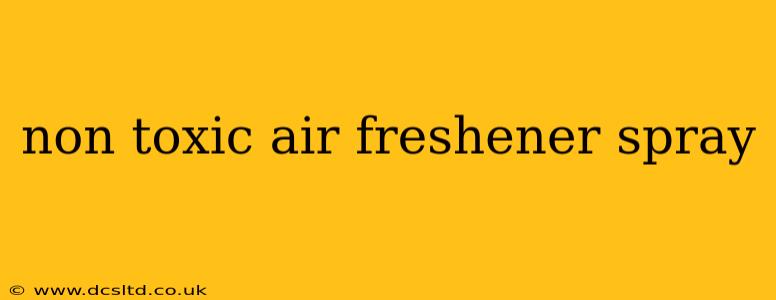Are you tired of harsh chemical air fresheners filling your home with artificial scents and potentially harmful ingredients? You're not alone! Many people are seeking safer, more natural alternatives to freshen their living spaces. This comprehensive guide explores the world of non-toxic air freshener sprays, helping you choose the best option for your family and your home. We'll cover everything from DIY recipes to commercially available options, addressing common concerns and offering expert advice.
What Makes an Air Freshener "Non-Toxic"?
Before diving into specific products, let's define what constitutes a truly non-toxic air freshener. It's crucial to understand that the term "non-toxic" isn't strictly regulated, so it's vital to examine the ingredient list carefully. A truly non-toxic air freshener should be free from:
- Volatile Organic Compounds (VOCs): These chemicals can contribute to indoor air pollution and cause respiratory problems. Common VOCs found in conventional air fresheners include phthalates, formaldehyde, and limonene.
- Synthetic Fragrances: These often mask unpleasant odors rather than eliminating them and can trigger allergies or sensitivities. Look for products that use essential oils for fragrance.
- Harsh Chemicals: Avoid products containing propellants, parabens, and other potentially harmful chemicals.
- Artificial Colors: These are unnecessary additives and can contribute to potential health concerns.
How to Make Your Own Non-Toxic Air Freshener Spray
Making your own air freshener is a fantastic way to control the ingredients and ensure a truly non-toxic product. Here's a simple recipe:
Ingredients:
- 1 cup distilled water
- 1/4 cup vodka (or witch hazel as a preservative)
- 15-20 drops of essential oils (choose your favorite scent blend – lavender, lemon, tea tree, and eucalyptus are popular choices)
Instructions:
- Combine distilled water and vodka (or witch hazel) in a spray bottle.
- Add essential oils and shake well to combine.
- Spray lightly around your home, avoiding direct contact with surfaces.
Important Note: Always test a small area first to ensure there are no adverse reactions to the essential oils used.
What are the Best Commercial Non-Toxic Air Freshener Sprays?
While DIY options provide ultimate control, many excellent commercially available non-toxic air fresheners offer convenience. However, remember to always check the label for ingredients before purchasing. Look for products that clearly state they are free from VOCs, synthetic fragrances, and other harmful chemicals. Read reviews to see what other consumers are saying about the scent and effectiveness.
Many brands focus on natural and organic ingredients. Always examine the complete ingredient list.
Are Essential Oil Diffusers a Better Alternative?
Essential oil diffusers offer another excellent way to scent your home naturally, without the use of propellants or potentially harmful chemicals. Diffusers disperse essential oils into the air through various methods, creating a pleasant and natural aroma. They generally offer a more subtle and long-lasting scent compared to sprays.
What are the Benefits of Using Non-Toxic Air Fresheners?
Switching to non-toxic air fresheners offers numerous benefits:
- Improved Indoor Air Quality: Eliminates harsh chemicals that can contribute to respiratory issues and other health problems.
- Reduced Allergic Reactions: Synthetic fragrances are common allergens. Natural alternatives minimize these risks.
- Healthier Home Environment: Creates a more comfortable and healthier space for you, your family, and your pets.
- More Pleasant Scents: Natural essential oils offer more complex and nuanced fragrances compared to synthetic alternatives.
How Often Should I Spray Non-Toxic Air Freshener?
The frequency of spraying depends on your preference and the strength of your chosen spray. Start with a light mist and adjust as needed. Over-spraying can be ineffective and might even cause a headache. Regular airing out of your home is a beneficial addition to any air freshening strategy.
What are the Common Mistakes People Make When Using Air Fresheners?
- Over-spraying: This can lead to headaches and doesn't necessarily provide a better scent.
- Not checking ingredients: Always read the labels to ensure the product is truly non-toxic.
- Ignoring underlying odors: Air fresheners mask odors; addressing the source (cleaning, airing out the space) is crucial.
By following these guidelines and selecting a non-toxic air freshener spray, you can create a healthier, more fragrant home environment for yourself and your loved ones. Remember, a well-ventilated and regularly cleaned home is the best foundation for a pleasant-smelling space, regardless of the air freshener you choose.
